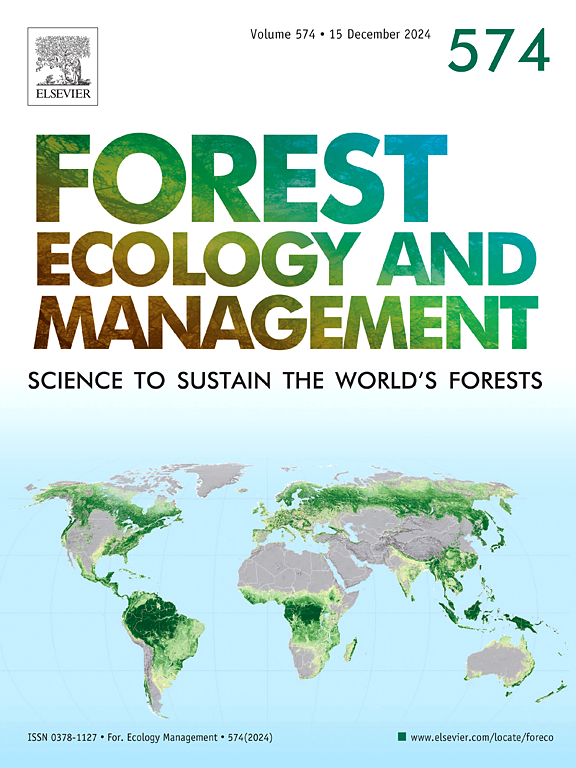微生物“特定群”的丰度显著影响伐木呼吸
IF 3.7
2区 农林科学
Q1 FORESTRY
引用次数: 0
摘要
被砍伐的原木是森林生态系统的重要组成部分,其呼吸作用释放的二氧化碳对全球气候变化和碳循环具有重要意义。被砍伐原木的呼吸作用主要是由微生物代谢活动引起的。然而,环境因素调控这些活动的机制尚不清楚。因此,目前关于被砍伐原木碳释放的模型存在显著偏差。为此,本研究以2013年和2022年同一样地为研究对象,测定了不同分解阶段(DSs)伐倒栎树(Quercus aliena var. acuteserata)和油松(Pinus tabulaeformis)伐倒木材的呼吸速率(Rlog)、温度、水分、化学元素含量和微生物群落结构。目的是阐明与Rlog相关的因素之间复杂的因果关系和相互依赖性。主要发现包括:1)Rlog随分解量的增加而显著增加,其中尖叶青的平均Rlog (4.12 μmolCO2·m−2·s−1)显著高于油松(3.77 μmolCO2·m−2·s−1);2) 2013 ~ 2022年被伐原木物化性质差异显著,受树种和DSs控制,水分、N、P、Ca、Mg含量随DSs的增加而显著增加,K含量显著降低(P <; 0.05);3) 2013年和2022年,不同DSs下被砍伐原木的优势微生物为变形菌门、厚壁菌门、放线菌门、酸杆菌门、拟杆菌门(细菌)和担子菌门、子囊菌门(真菌);4)两年内差异显著的微生物丰度(“特定群体”),包括Basidiomycota、Proteobacteria、Cyanobacteria和Chlamydiota等,与Rlog密切相关,但微生物多样性指标与Rlog无显著相关;5)水分对Rlog的影响最大,其次是Ca、Mg、K、P、N含量和温度,后期影响最大。这些结果表明,未来对Rlog机制的研究应侧重于在被砍伐的原木中具有显著时空丰度差异的微生物。此外,被砍伐原木的碳排放模型应考虑水分和温度对Rlog的综合影响,以及木材特性(树种、DS和化学元素含量)的中介作用,以提高未来Rlog预测的准确性。本文章由计算机程序翻译,如有差异,请以英文原文为准。
The abundance of microbial "specific groups" significantly influences downed log respiration
Downed logs are an important component of the forest ecosystem, and the CO2 released through their respiration is significant for global climate change and the carbon cycle. Respiration in downed logs primarily results from microbial metabolic activities. However, the mechanisms by which environmental factors regulate these activities remain unclear. Consequently, current models for carbon release from downed logs exhibit significant deviations. Therefore, this study investigates the same forest plots at 2013 and 2022 to measure the respiration rate (Rlog), temperature, moisture, chemical element contents, and microbial community structure of downed logs from Quercus aliena var. acuteserrata and Pinus tabulaeformis at various decomposition stages (DSs). The aim is to elucidate the complex causal relationships and interdependencies among factors related to Rlog. Key findings include: 1) Rlog increases significantly with decomposition, with Q. aliena var. acuteserrata exhibiting a significantly higher average Rlog (4.12 μmolCO2·m−2·s−1) than P. tabulaeformis (3.77 μmolCO2·m−2·s−1); 2) Significant differences in physicochemical properties of downed logs between 2013 and 2022, controlled by tree species and DSs, and the contents of moisture, N, P, Ca and Mg were significantly increased with the increase of DSs, while the content of K was significantly decreased (p < 0.05); 3) In both 2013 and 2022, the dominant microorganisms in downed logs at different DSs included Proteobacteria, Firmicutes, Actinobacteria, Acidobacteria, Bacteroidetes (bacteria) and Basidiomycota, Ascomycota (fungi); 4) The abundance of microorganisms with significant difference between the two years ("specific groups"), including Basidiomycota, Proteobacteria, Cyanobacteria and Chlamydiota, etc, was closely correlated with Rlog, although no significant correlation was found between microbial diversity indices and Rlog; and 5) moisture emerged as the most influential factor on Rlog, followed by Ca, Mg, K, P, N contents, and temperature, particularly in later DSs. These results suggest that future research on Rlog mechanisms should focus on microorganisms with significant temporal and spatial abundance differences in downed logs. Furthermore, carbon emission models for downed logs should consider the combined effects of moisture and temperature on Rlog, along with the mediating role of wood characteristics (species, DS, and chemical element contents), to improve the accuracy of future Rlog predictions.
求助全文
通过发布文献求助,成功后即可免费获取论文全文。
去求助
来源期刊

Forest Ecology and Management
农林科学-林学
CiteScore
7.50
自引率
10.80%
发文量
665
审稿时长
39 days
期刊介绍:
Forest Ecology and Management publishes scientific articles linking forest ecology with forest management, focusing on the application of biological, ecological and social knowledge to the management and conservation of plantations and natural forests. The scope of the journal includes all forest ecosystems of the world.
A peer-review process ensures the quality and international interest of the manuscripts accepted for publication. The journal encourages communication between scientists in disparate fields who share a common interest in ecology and forest management, bridging the gap between research workers and forest managers.
We encourage submission of papers that will have the strongest interest and value to the Journal''s international readership. Some key features of papers with strong interest include:
1. Clear connections between the ecology and management of forests;
2. Novel ideas or approaches to important challenges in forest ecology and management;
3. Studies that address a population of interest beyond the scale of single research sites, Three key points in the design of forest experiments, Forest Ecology and Management 255 (2008) 2022-2023);
4. Review Articles on timely, important topics. Authors are welcome to contact one of the editors to discuss the suitability of a potential review manuscript.
The Journal encourages proposals for special issues examining important areas of forest ecology and management. Potential guest editors should contact any of the Editors to begin discussions about topics, potential papers, and other details.
 求助内容:
求助内容: 应助结果提醒方式:
应助结果提醒方式:


